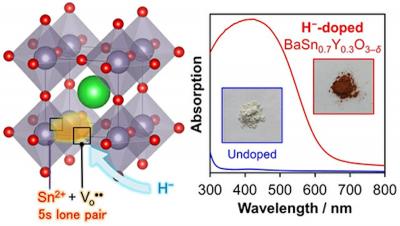Semiconductors that can exploit the omnipresent visible spectrum of light for different technological applications are highly sought after, but such semiconductors are often dexpensive and toxic. A group of scientists from Tokyo Institute of Technology and Kyushu University have collaborated to develop a low-cost and non-toxic narrow-gap semiconductor material with potential 'light-based' or photofunctional applications.

Tin-containing oxide semiconductors are cheaper than most semiconductor materials, but their photofunctional applications are constrained by a wide optical band gap. The team of scientists, led by Dr. Kazuhiko Maeda, Associate Professor at the Department of Chemistry, Tokyo Institute of Technology, developed a perovskite-based semiconductor material that is free of toxic lead and can absorb a wide range of visible light.
The scientists were also able to pinpoint a crucial tin reduction reaction in the semiconductor material through physicochemical measurements. This reduction leads to the generation of a "tin lone electron pair", whose different electronic states notably contribute to the visible light absorption of the material.
They also attribute this desired property to the prior introduction of oxygen defects into the material. Highlighting the importance of the oxygen defects, Dr. Maeda, who is also a corresponding author of the study, explains, "The prior introduction of oxygen defects into BaSnO3 by Y3+ substitution for Sn4+ is also indispensable to realize a significant reduction of the band gap."
To confirm that the developed semiconductor material is indeed photofunctional, the scientists tested the applicability of the semiconductor material in a photoelectrode. They observed that the developed material gave a clear anodic photoresponse up to the expected 600 nm.
Explaining the impact of the study, Dr. Katsuro Hayashi, Professor of the Faculty of Engineering, Kyushu University, and the other corresponding author of the study, says, "Overall, the study has enabled a giant leap in the development of a cheaper, non-toxic, narrow optical band gap, tin-containing semiconductor material for practical applications in solar cells, photocatalysis and pigments."



